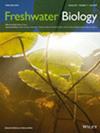How Do Environmental and Spatial Factors Influence Beta Diversity and Composition of Abundant and Rare Bacterioplankton Communities in Lakes From the Patagonian Plateaus?
IF 2.8
2区 生物学
Q2 ECOLOGY
引用次数: 0
Abstract
- Lakes in the same geographic region often exhibit outstanding differences in environmental features, as is the case in the high-altitude lakes from the basaltic plateaus of Patagonia (Argentina).
- We analysed bacterial community composition (BCC) at local and regional scales in 37 shallow lakes on two Patagonian plateaus and evaluated the influence of environmental variables and geographic position on community structure.
- β diversity within each plateau was the key component of regional bacterioplankton diversity. The sum of amplicon sequence variants (ASV) exclusive to each plateau was greater than 50%. Most of the exclusive ASVs corresponded to rare ones from each plateau, whereas abundant ASVs were mostly shared by both plateaus (81%), which indicates a more restricted distribution of rare and higher dispersal of abundant ASVs.
- The lakes of the Strobel and Buenos Aires plateaus spanned a wide range of environmental conditions, which were associated with the BCC of lakes from both plateaus. Macrophyte cover, fish presence, conductivity, dissolved organic carbon, pH, and altitude were associated with BCC in these lakes. Notably, differences at the phylum and class levels were observed in lakes with contrasting limnological features. Fishless lakes had significantly greater relative abundance of Bacteroidia and Gammaproteobacteria than fish-stocked lakes. Lakes without macrophytes showed significantly higher relative abundances of Cyanobacteria and Planctomycetota than vegetated environments, and, conversely, vegetated lakes exhibited the highest relative abundance of Bacteroidota.
- Our study shows a strong link between BCC and environmental factors, regardless of their regional or local classifications. Rare bacteria were more strongly associated with spatial factors than total or abundant bacteria, suggesting a limited dispersal capacity. Our findings highlight that variability in environmental conditions influences BCC and determines high β diversity and, consequently, high γ diversity.
环境和空间因素如何影响巴塔哥尼亚高原湖泊丰富和稀有浮游细菌群落的多样性和组成?
同一地理区域的湖泊往往在环境特征上表现出明显的差异,巴塔哥尼亚(阿根廷)玄武岩高原的高海拔湖泊就是这种情况。本文分析了巴塔哥尼亚两个高原上37个浅湖的局部和区域尺度上的细菌群落组成,并评价了环境变量和地理位置对群落结构的影响。各高原内β多样性是区域浮游细菌多样性的关键组成部分。各平台特有的扩增子序列变异(ASV)的总和大于50%。各高原的罕见型asv与排他性asv多相对应,而丰富型asv多为两个高原共有(81%),表明稀有型asv的分布较为有限,丰富型asv的扩散程度较高。斯特罗贝尔高原和布宜诺斯艾利斯高原的湖泊跨越了广泛的环境条件,这与两个高原湖泊的BCC有关。大型植物覆盖、鱼类存在、电导率、溶解有机碳、pH和海拔高度与这些湖泊的BCC相关。值得注意的是,在具有不同湖泊特征的湖泊中,观察到门和纲水平的差异。无鱼湖泊的拟杆菌属和γ变形菌属的相对丰度显著高于放鱼湖泊。没有大型植物的湖泊蓝藻和plantomycetota的相对丰度显著高于有植被的湖泊,相反,有植被的湖泊Bacteroidota的相对丰度最高。我们的研究表明,无论区域或地方分类如何,BCC与环境因素之间存在很强的联系。稀有细菌与空间因子的相关性高于总数或丰度细菌,表明其扩散能力有限。我们的研究结果强调了环境条件的可变性影响BCC,并决定了高β多样性,从而决定了高γ多样性。
本文章由计算机程序翻译,如有差异,请以英文原文为准。
求助全文
约1分钟内获得全文
求助全文
来源期刊

Freshwater Biology
生物-海洋与淡水生物学
CiteScore
5.90
自引率
3.70%
发文量
162
审稿时长
2 months
期刊介绍:
Freshwater Biology publishes papers on all aspects of the ecology of inland waters, including rivers and lakes, ground waters, flood plains and other freshwater wetlands. We include studies of micro-organisms, algae, macrophytes, invertebrates, fish and other vertebrates, as well as those concerning whole systems and related physical and chemical aspects of the environment, provided that they have clear biological relevance.
Studies may focus at any level in the ecological hierarchy from physiological ecology and animal behaviour, through population dynamics and evolutionary genetics, to community interactions, biogeography and ecosystem functioning. They may also be at any scale: from microhabitat to landscape, and continental to global. Preference is given to research, whether meta-analytical, experimental, theoretical or descriptive, highlighting causal (ecological) mechanisms from which clearly stated hypotheses are derived. Manuscripts with an experimental or conceptual flavour are particularly welcome, as are those or which integrate laboratory and field work, and studies from less well researched areas of the world. Priority is given to submissions that are likely to interest a wide range of readers.
We encourage submission of papers well grounded in ecological theory that deal with issues related to the conservation and management of inland waters. Papers interpreting fundamental research in a way that makes clear its applied, strategic or socio-economic relevance are also welcome.
Review articles (FRESHWATER BIOLOGY REVIEWS) and discussion papers (OPINION) are also invited: these enable authors to publish high-quality material outside the constraints of standard research papers.
 求助内容:
求助内容: 应助结果提醒方式:
应助结果提醒方式:


